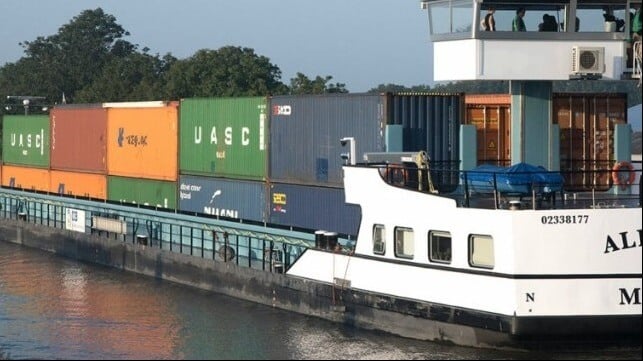First Dutch Zero-Emission Inland Vessel Uses Interchangeable Batteries

Inland shipping is one of the areas that is becoming an early adopter of innovative zero-emission shipping. Recently, the first Dutch vessel using a unique system of interchangeable batteries launched as part of a plan to build out the system known as ZES (Zero Emission Service) across the waterways in the Netherlands.
The Alphenaar, a 295-foot inland cargo barge, became the first vessel to operate under the ZES system sailing between Alphen aan den Rijn and Moerdijk transporting beer for Heineken. Together with CCT shipping, Heineken is the first ZES customer with a ten-year contract to operate between the Heineken brewery in Zoeterwoude and the Port of Rotterdam.
Each vessel will be converted to operate on a rechargeable battery pack known as a ZESpack that can provide up to 2000 kWh, good for approximately two to four hours of sailing at a distance between approximately 35 to 75 miles. The battery packs are in a standard 20-foot container and plug in to a standard connector. ZES is also making available the profile of the connector without rights so that the market can work with various suppliers of energy containers.
The first ZESpacks were developed by Wärtsilä and consist of 45 battery modules totaling 2 MWh which is comparable to the capacity of around 36 electric cars. The battery pack can be recharged in about two and a half hours on dedicated recharging stations that will be placed along the route.
According to ZES, the system is made attractive to the vessel operators as they pay only for the power used. In combination with the financing and pay-per-use package devised by ING, the vessel sails along the routes and will interchange batteries at charging stations. Changing out the battery packs requires no more than 15 minutes.
The ZESpacks currently in use work with lithium-ion batteries, but the company’s future goal is to convert them to alternative fuels such as hydrogen or ammonia. The charging stations will be powered with green energy and in addition to charging, the battery packs can be used as energy hubs that can stabilize the grid during peak loads and where other vehicles can also charge.
The first charging station developed by ENGIE was delivered in April and was established at CCT’s container terminal in Alphen aan den Rijn. The Alphenaar was converted and fitted with the plug connection for the ZESpacks in July and the first trials were completed at the end of August.
ZES’s goal is to scale up to eight vessels, eight loading stations, and fourteen ZESpacks in the short term. The company aims to realize 30 zero-emission shipping routes by 2030. The company was founded last year by ENGIE, ING, Wärtsilä, and the Port of Rotterdam Authority with the support of the Ministry of Infrastructure and Water Management of the Netherlands.

that matters most
Get the latest maritime news delivered to your inbox daily.
“The energy concept that ZES is launching on the market contributes directly to the reduction of emissions by saving around 1,000 tons of CO2 and 7 tons of NOx per vessel per year. In addition, vessels sailing with ZES do not produce particulate matter and noise,’ says Willem Dedden, CEO of ZES.
The project is seen as a model for further expansion of zero-emission shipping both inland and in ports across Europe. Within the transport sector, inland shipping makes up five percent of CO2 emissions in the Netherlands, while they estimate 11 percent of the total Dutch NOx emissions are caused by inland shipping. To achieve the goals set in the Climate Agreement, the Green Deal for Sea Shipping, Inland Shipping and Ports aim to reduce emissions in inland shipping by 50 percent by 2030 and they believe electrification will play a key role in meeting these goals.
